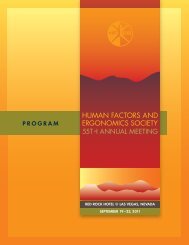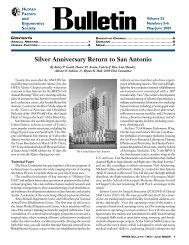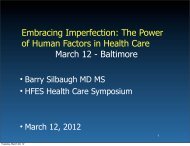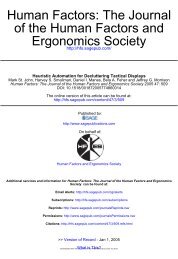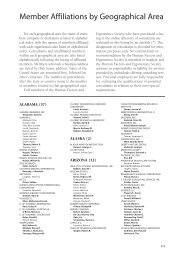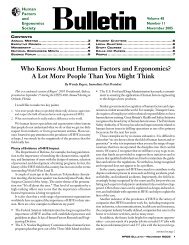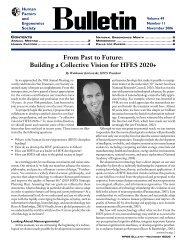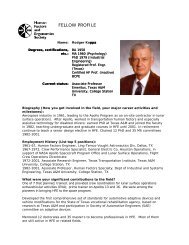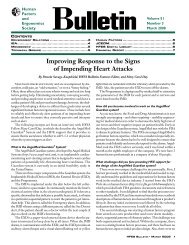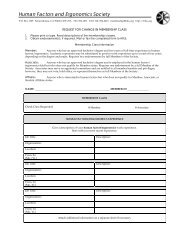MOBILE-READY - Human Factors and Ergonomics Society
MOBILE-READY - Human Factors and Ergonomics Society
MOBILE-READY - Human Factors and Ergonomics Society
Create successful ePaper yourself
Turn your PDF publications into a flip-book with our unique Google optimized e-Paper software.
THURSDAYThursday, September 307:15 to 8:00 a.m.Early-Morning Madness7:15 to 8:00 a.m.Gr<strong>and</strong> Ballroom B (Street Level)Thursday, September 308:30 to 10:00 a.m.A2 – AGING AND COGNITIVE FUNCTIONLectureThursday, September 30, 2010, 8:30 to 10:00 a.m.Bayview B (Bay Level)AgingChair: Christopher Mayhorn, North Carolina State U.1. Paul Y. Kim <strong>and</strong> Christopher B. Mayhorn, NorthCarolina State U., Exploring Age-RelatedDifferences in Prospective Memory Inside<strong>and</strong> Outside of the Lab2. Ann E. Lambert, Jason M. Watson, Joel M. Cooper,<strong>and</strong> David L. Strayer, U. of Utah, The Roles ofWorking Memory Capacity, Visual Attention,<strong>and</strong> Age in Driving Performance3. Sara E. McBride, Wendy A. Rogers, <strong>and</strong> Arthur D.Fisk, Georgia Tech, Do Younger <strong>and</strong> OlderAdults Differentially Depend on an AutomatedSystem?4. Laura D’Andrea, Dan Morrow, <strong>and</strong> ElizabethStine-Morrow, U. of Illinois at Urbana-Champaign;Matthew Shake, St. Bonaventure U.; Sven Bertel,Katie Kopren, <strong>and</strong> Jessie Chin, U. of Illinois atUrbana-Champaign; Thembi Connor-Garcia <strong>and</strong>James Graumlich, U. of Illinois College of Medicine;Michael Murray, Purdue U., Impact ofHealth Knowledge on Older Adults’ Comprehensionof Multimedia Health Information5. Christopher M. Kelley <strong>and</strong> Anne CollinsMcLaughlin, North Carolina State U., FeedbackRequirements for Older Adult Learning: DoCognitive Abilities Matter?CE6 – HUMAN-AUTOMATION INTERACTIONLectureThursday, September 30, 2010, 8:30 to 10:00 a.m.Gr<strong>and</strong> Ballroom B (Street Level)Cognitive Engineering & Decision MakingChair: Ernesto Bustamante, U. of Idaho; Cochair:Priyadarshini Pennathur, U. at Buffalo, SUNY1. Juliane Reichenbach, Linda Onnasch, <strong>and</strong>Dietrich Manzey, Berlin Inst. of Technology,Misuse of Automation: The Impact of SystemExperience on Complacency <strong>and</strong> AutomationBias in Interaction With Automated Aids2. Shih-Yi Chien, Huadong Wang, <strong>and</strong> MichaelLewis, U. of Pittsburgh, <strong>Human</strong> VersusAlgorithmic Path Planning for Search <strong>and</strong>Rescue by Robot Teams3. Thomas Robinson <strong>and</strong> Catherine Burns, U. ofWaterloo, A Learning Process: Old Strategies,New Tools4. Christopher D. Wickens, Alion Science <strong>and</strong>Technology; Huiyang Li, U. of Michigan; AmySantamaria <strong>and</strong> Angelia Sebok, Alion Science <strong>and</strong>Technology; Nadine Sarter, U. of Michigan, Stages<strong>and</strong> Levels of Automation: An IntegratedMeta-Analysis5. Robert L. Wears, U. of Florida, Exploring theDynamics of ResilienceCS3 – USABILITY AND EVALUATIONLectureThursday, September 30, 2010, 8:30 to 10:00 a.m.Garden A (Atrium Lobby Level)Computer Systems; cosponsored by InternetChair: Joseph Goldberg, Oracle Corp.; Cochair: H. C.Neil Ganey, Lenovo1. Martin L. Fracker, IBM Interactive, ScalingUsability in Terms of Requirements: AMethod for Evaluating User Interfaces2. Curt B. Irwin, Sacha N. Duff, Jenny L. Skye,Douglas A. Wiegmann, <strong>and</strong> Mary E. Sesto, U. ofWisconsin-Madison, Disability <strong>and</strong> Orientation-Specific Performance During a ReciprocalTapping Task3. Asanka S. Rodrigo <strong>and</strong> Ravindra S. Goonetilleke,Hong Kong U. of Science <strong>and</strong> Technology,Designing Flight Information Displays forQuick Information Access: A Case Study ofan International Airport4. Joseph H. Goldberg <strong>and</strong> Jonathan I. Helfman,Oracle Corp., Identifying Aggregate ScanningStrategies to Improve Usability Evaluations5. Martin L. Fracker, Michael Heck, <strong>and</strong> GeorgeGoeschel, IBM, When a User Interface IsGood Enough: User Ratings in UI DesignE3 – TEACHING, LEARNING, OR BOTHLectureThursday, September 30, 2010, 8:30 to 10:00 a.m.Seacliff D (Bay Level)EducationChair: Nancy Stone, Missouri U. of Science &Technology; Cochair: R<strong>and</strong>a Shehab, U. of Oklahoma1. Anne Collins McLaughlin, North Carolina StateU.; Wendy A. Rogers, Georgia Tech, Learningby Doing: Underst<strong>and</strong>ing Skill AcquisitionThrough Skill Acquisition2. Kim Graves Wolfinbarger, U. of Oklahoma, ANew Approach to Laboratory-Based Learningin an Introductory <strong>Ergonomics</strong> Course3. Joseph R. Keebler, Scott Ososky, Florian Jentsch,<strong>and</strong> Thomas Fincannon, U. of Central Florida,Gaining Ground: Merging Cognitive LoadTheory With <strong>Human</strong> <strong>Factors</strong> Principles4. Sahika Vatan Korkmaz <strong>and</strong> Carolyn M.Sommerich, Ohio State U., Teaching HealthyComputing Skills to High School Studentsvia Participatory <strong>Ergonomics</strong>5. Michelle L. Rogers, Drexel U., Teaching HCIDesign Principles Using Culturally CurrentMediaGS7 – FACILITATING UNIVERSITY-INDUSTRYCOLLABORATIONS IN HUMAN FACTORSAND ERGONOMICSDiscussion PanelThursday, September 30, 2010, 8:30 to 10:00 a.m.Seacliff B (Bay Level)General SessionsChair: Wendy A. Rogers, Georgia TechPanelists: Barry H. Beith, <strong>Human</strong>Centric; Jerry R.Duncan, Deere & Co.; Mica R. Endsley, SATechnologies; Peter A. Hancock, U. of Central FloridaHC6 – PATIENT SAFETY IN THE OPERATINGTHEATREInvited SymposiumThursday, September 30, 2010, 8:30 to 10:00 a.m.Garden Room B (Atrium Lobby Level)Health CareChair: Tanja Manser, U. of Aberdeen; Cochair: HeidiManijeh Mehrzad, Embry-Riddle Aeronautical U.1. Tanja Manser <strong>and</strong> Rhona Flin, U. of Aberdeen,Patient Safety in the Operating Theatre:Symposium Overview2. Michaela Kolbe <strong>and</strong> Barbara Künzle, ETHZurich; Enikö Zala-Mezö, PädagogischeHochschule Zurich; Michael J. Burtscher, ETHZurich; Johannes Wacker, U. Hospital Zurich;Donat R. Spahn, U. Hospital Zurich; GudelaGrote, ETH Zurich, The Functions of TeamMonitoring <strong>and</strong> “Talking to the Room” forPerformance in Anesthesia Teams3. Lucy Mitchell, Rhona Flin, <strong>and</strong> Steven Yule, U.of Aberdeen; Janet Mitchell, Aberdeen RoyalInfirmary; Kathy Coutts <strong>and</strong> George Youngson,Royal Aberdeen Children’s Hospital, ThinkingAhead of the Surgeon: Developing a BehavioralRating System for Scrub Practitioners’Non-Technical Skills (SPLINTS)4. Sarah Henrickson Parker, Steven Yule, <strong>and</strong> RhonaFlin, U. of Aberdeen; Aileen McKinley, AberdeenRoyal Infirmary, A Preliminary Investigation ofSurgeons’ Leadership in the Operating Room5. Douglas A. Wiegmann, U. of Wisconsin-Madison,Analysis of Error Management StrategiesDuring Cardiac Surgery: Theoretical <strong>and</strong>Practical Implications6. Steven K. Howard <strong>and</strong> James I. Fann, StanfordU. School of Medicine, Improving Patient Safetyin the Heart Room Through SimulationIE5 – HAND TOOL ERGONOMICS—PAST ANDPRESENTDiscussion PanelThursday, September 30, 2010, 8:30 to 10:00 a.m.Gr<strong>and</strong> Ballroom A (Street Level)Industrial <strong>Ergonomics</strong>Chair: Thomas J. Armstrong, U. of MichiganPanelists: David J. Cochran <strong>and</strong> Peter A. Bleed, U. ofNebraska; Jia-Hua Lin, Liberty Mutual Research Inst.for Safety; Andris Freivalds, Pennsylvania State U.;Robert G. Radwin, U. of Wisconsin-Madison; David M.Rempel, U. of California, BerkeleyME3 – THE VIEW FROM THE TOP:MACROERGONOMICS IN ACTIONLectureThursday, September 30, 2010, 8:30 to 10:00 a.m.Marina Room (Bay Level)MacroergonomicsChair: Valerie J. Rice, U.S. Army Research Lab;Cochair: Petra E. Alfred, U.S. Army Research Lab1. Annette Shtivelb<strong>and</strong> <strong>and</strong> John Rosecrance,Colorado State U., Gaining Organizational Buy-In: Lessons Learned From Fifty Ergonomists2. Celal Gungor, Auburn U., Company Size <strong>and</strong><strong>Human</strong> <strong>Factors</strong> <strong>and</strong> <strong>Ergonomics</strong> Awareness3. Sara Kraemer <strong>and</strong> Elisabeth Geraghty, U. ofWisconsin-Madison; Deborah Lindsey <strong>and</strong>Cynthia Raven, Milwaukee Public Schools,School Leadership View of <strong>Human</strong> <strong>and</strong>Organizational <strong>Factors</strong> in PerformanceManagement: A Comparative Analysis ofHigh- <strong>and</strong> Low-Performing Schools4. Natalie Schwatka, Erica Ermann, KristaHoffmeister, John Rosecrance, <strong>and</strong> David Gilkey,Colorado State U., Safety Climate in Agriculture5. Ari Antonovsky, Clare Pollock, <strong>and</strong> Leon Straker,Curtin U. of Technology, Identification of the<strong>Human</strong> <strong>Factors</strong> Contributing to MaintenanceFailures in a Petroleum OperationPD5 – METHODOLOGY FOR CREATINGAN ANTHROPOMETRIC DATABASE FORWORKSTATION SETUP USING CAESAR,NATICK, AND NHANESDiscussion PanelThursday, September 30, 2010, 8:30 to 10:00 a.m.Seacliff A (Bay Level)Product DesignChair/Presenter: Scott Openshaw, Allsteel Inc.;Cochair/Presenter: David Trippany, Steelcase, Inc.SD4 – HUMAN FACTORS STANDARDS FORU.S. GOVERNMENT AGENCIESDiscussion PanelThursday, September 30, 2010, 8:30 to 10:00 a.m.Hospitality Room (Atrium Lobby Level)System DevelopmentChair: Barry Tillman, Lockheed Martin\NASAPanelists: Vicki Ahlstrom, Federal Aviation Admin.;John Lockett, U.S. Dept. of Defense; Janis Connolly<strong>and</strong> Dane Russo, NASA



